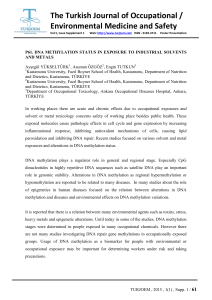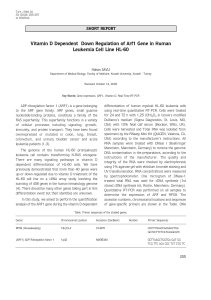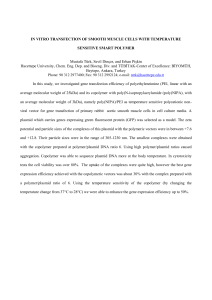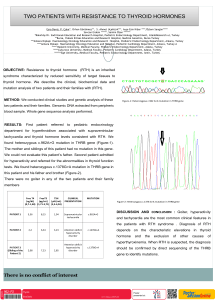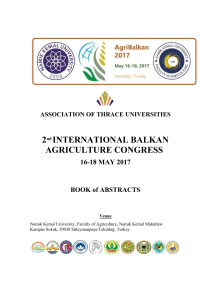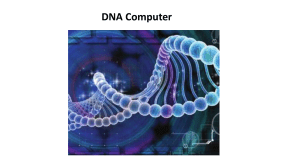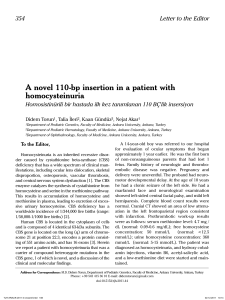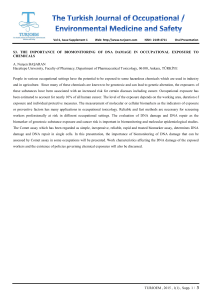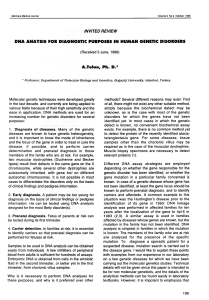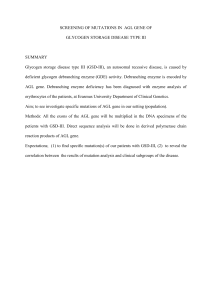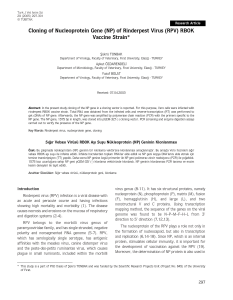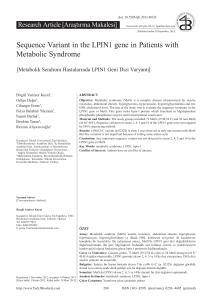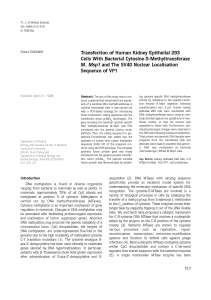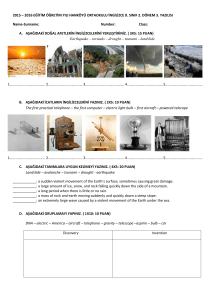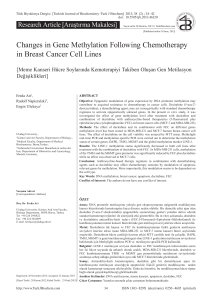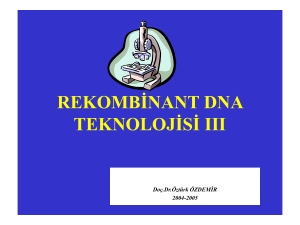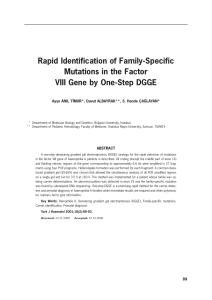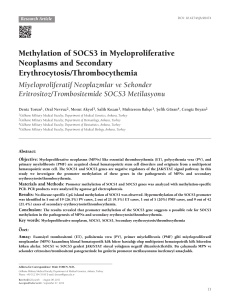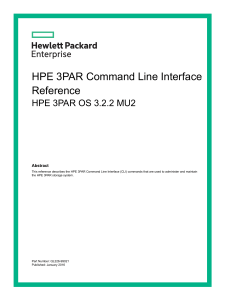Variable Expression and Hypermethylation of
advertisement
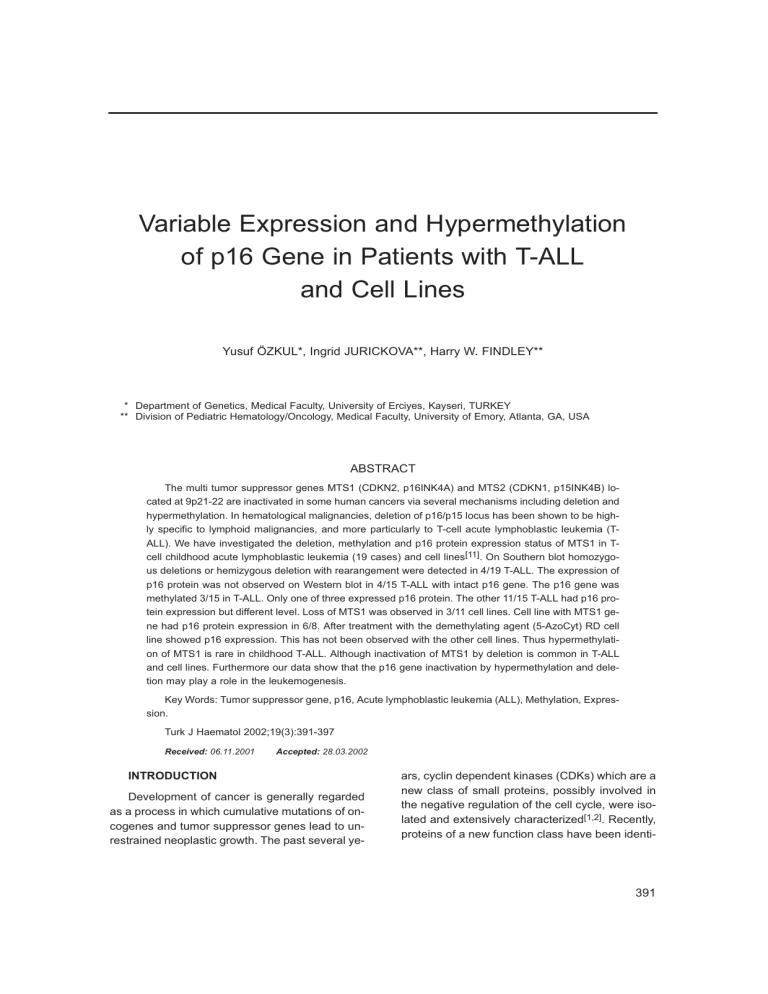
Variable Expression and Hypermethylation of p16 Gene in Patients with T-ALL and Cell Lines Yusuf ÖZKUL*, Ingrid JURICKOVA**, Harry W. FINDLEY** * Department of Genetics, Medical Faculty, University of Erciyes, Kayseri, TURKEY ** Division of Pediatric Hematology/Oncology, Medical Faculty, University of Emory, Atlanta, GA, USA ABSTRACT The multi tumor suppressor genes MTS1 (CDKN2, p16INK4A) and MTS2 (CDKN1, p15INK4B) located at 9p21-22 are inactivated in some human cancers via several mechanisms including deletion and hypermethylation. In hematological malignancies, deletion of p16/p15 locus has been shown to be highly specific to lymphoid malignancies, and more particularly to T-cell acute lymphoblastic leukemia (TALL). We have investigated the deletion, methylation and p16 protein expression status of MTS1 in Tcell childhood acute lymphoblastic leukemia (19 cases) and cell lines[11]. On Southern blot homozygous deletions or hemizygous deletion with rearangement were detected in 4/19 T-ALL. The expression of p16 protein was not observed on Western blot in 4/15 T-ALL with intact p16 gene. The p16 gene was methylated 3/15 in T-ALL. Only one of three expressed p16 protein. The other 11/15 T-ALL had p16 protein expression but different level. Loss of MTS1 was observed in 3/11 cell lines. Cell line with MTS1 gene had p16 protein expression in 6/8. After treatment with the demethylating agent (5-AzoCyt) RD cell line showed p16 expression. This has not been observed with the other cell lines. Thus hypermethylation of MTS1 is rare in childhood T-ALL. Although inactivation of MTS1 by deletion is common in T-ALL and cell lines. Furthermore our data show that the p16 gene inactivation by hypermethylation and deletion may play a role in the leukemogenesis. Key Words: Tumor suppressor gene, p16, Acute lymphoblastic leukemia (ALL), Methylation, Expression. Turk J Haematol 2002;19(3):391-397 Received: 06.11.2001 Accepted: 28.03.2002 INTRODUCTION Development of cancer is generally regarded as a process in which cumulative mutations of oncogenes and tumor suppressor genes lead to unrestrained neoplastic growth. The past several ye- ars, cyclin dependent kinases (CDKs) which are a new class of small proteins, possibly involved in the negative regulation of the cell cycle, were isolated and extensively characterized[1,2]. Recently, proteins of a new function class have been identi- 391 Özkul Y, Jurickova I, Findley HW. fied which inhibit the CDK activity but which are distinct from the kinases that phosphorylate and inactivate CDKs. Such proteins are called CDIs. These proteins are of interest because of the negative regulation of the CDK activities at appropriate time points in the cell cycle. These genes were shown to represent families of proteins. The mammalian CDIs up to date include p21, p27, p28, p20, p16, p15 and p18[3,4]. A high frequency of loss of heterozygosity on chromosome 9p21 has suggested the presence of one or more tumor suppressor genes in this region. Datas to date suggest that the gene involved in this region is p16. Homozygous deletion is a frequent mechanism for inactivation of this putative tumor suppressor gene in cell line and ALL patients[5]. The p16 gene is comprised of three coding exons consisting of 126, 307, and 11 base pairs, respectively. Mutations are most common in exon 2. Mutated p16 cannot inhibit CDK4 kinase activity and cells in which p16 was mutated or deleted would be expected to have a growth advantage[6-8]. The p16 protein inhibits CDK4 and CDK6, which are key regulatory factors for the progression of eukaryotic cells through the G1 phase of the cell cycle[9]. The p15/MTS2/INK4B and the p16/ MTS1/INK4A genes have been reported to be altered in many types of cancers such as 40-50% homozygous deletion or point mutation were observed in primary breast carcinomas and 19% of bladder tumors and 37% of panctreatic carcinomas[10-12]. In hematological malignancies, the higher frequency of p15 del and p16 del were seen in acute lymphoblastic leukmia (> 30%) with striking rates in T-ALL (> 50%), but also low rates in B-cell precursor (BCP)-All (20%)[2,13,14]. Transcription repression by DNA-methylation of promoter and 5’ regulatory sequences may be a pathway to inactivate the p16 CDKN2 and p15INK4b genes. Global changes in DNA methylation patterns are known to occur during tumorgenesis, and gene silencing has been associated with methytation of CpG islands located in or nearby promoters and 5’ regulatory regions[15,16]. CpG islands are G + C rich regions that show a higher frequency of CpG dinucleotides that is nor- 392 Variable Expression and Hypermethylation of p16 Gene in Patients with T-ALL and Cell Lines mally seen in the vertebrate genome and that are not methylated in the germline. Widespread methylation of CpG island occurs on autosomal genes during oncogenic transformation[15,17]. Promoter silenced by methylation can be reactivated in many cases by treatment with the drug 5-azo2’-deoxycytidine (5-AzoCyt), which is a well known inhibitor of DNA methylation[18,19]. Methylation of p16 were found 50% of ALL cell lines, 50% of AML cell lines and 38% AML patients[20,21]. We hypothesized that abnormal DNA methylation might be an alternative mechanism for inactivation of the p16 gene in T-ALL and cell lines. MATERIALS and METHODS Patients, Cell Lines and Normal Controls We previously analyzed 27 cell lines including two AML cell lines for homozygous deletions of exons CDKN2 by Southern blot analyzing[22]. 9327, U937, RD, 93-10, EI, AE, 697, HL-60 cell lines which have p16 gene and p16 mRNA, have been selected for this research and 91-06, REH and 855 cell lines which have p16 deletion also chosen as a negative control in this research. The phenotypes of most of these cell line have been previously described, most have B-ALL phenotype. 93 10 (EU-9) has T-ALL phenotype. One myeloid cell line HL-60 and one non-Hodgkin’s lymphomas cell line, U937, was also examined in this study. Bone marrow or peripheral blood samples were collected from 19 patients with TALL. In all examined samples, the proportion of leukemic cell exceded 80% mononuclear cells were separated from the samples on Ficoll-Hypaque density gradient, suspended and kept at 80°C. Also 6 hematologically normal bone marrows were analyzed as positive control. Southern Blotting Genomic DNA was extracted from cell lines, patients and hematologically normal cases by proteinase K/detergent digestion, phenol-chloroform extraction and ethanol precipitation. Seven micrograms of genomic DNA was digested with HIND III and SMA I for overnight at 37°C, then se- Turk J Haematol 2002;19(3):391-397 Variable Expression and Hypermethylation of p16 Gene in Patients with T-ALL and Cell Lines parated by a 0.8% agarose gel electrophoresis; denatured; transferred to Nybond-membrane (Amersham, Buckinghamshine, UK) and fixed by baking in a vacuum oven at 80°C for 2 h. These DNA’s were prehybridized for 1 h at 65°C in a solution containing 6 x SSC, 10 x Denhardt’s, 1% SDS and 100 μg/mL denatured ssDNA and then hybridized overnight at 65°C in the same solution and previously labeled with p32 by the random priming technique probe which derived from either p16 exon one and exon two[22]. Analysis of Methylation of the 5’CpG Island of p16 Gene in Cell Lines The cell lines were maintained in RPMI-1640 with 10% fetal calf serum for the study of demethylation and they were treated with 1.0 μm 5azo-2-deoxycytidine. The drug was dissolved in cold DMEM immediately before use. The cells were incubated for 3 days with the medium and drug being replaced every 24 h. DNA and protein were harvested immediately following drug expression. DNA was extracted and Southern blotting performed according to the method described above. Western Blot Analysis Protein samples, equivalent to 106 cells were isolated using lysine buffer composed of 150 mM NaCl, 50 mM Tris (pH 8.0), 5 mM EDTA, 1% (v/v) nonidet p-40; 1 mM phenylmethylsulfonyl fluoride, 20 μg/mL aprotinin, and 25 μg/mL leupeptin for 1 h at 4°C. The cell debris were removed by centrifugation at 14.000 rpm at 4°C for 1 h. Supernatants were collected and the protein content of the lysate was determined by the Brodford protein assay (BIO-RAD) according to the manufacturer instructions. Ten micrograms of total cellular protein was run per lane on a 12.5% SDS-polyacrylamide gel and transferred to Nitrocellulose (BIORAD). Membrane was blocked 30 min in 5.0% dry milk, 10 mM Tris-HCI pH 8.0, 150 mM NaCl, 2.0% BSA, 0.02% NaV3. The blocked membrane was then incubated with the monoclonal antibody anti p16, clone G175.405 (Pharmingen San Giego, CA) used 0.2 μg/mL overnight at 4°C. followed by three washes in 10 mM Tris-HCL, pH 8.0, 150 mM NaCl and 0.05% Tween 20 for 15 min each. The Turk J Haematol 2002;19(3):391-397 Özkul Y, Jurickova I, Findley HW. secondary antibodies was a 1:2500 dilution of peroxidase-conjugated anti-mouse (Dako Ltd, High Wycombe, UK) as appropriate. Detection was enhanced chemiluminescence (ECL: Amersham, UK) according to the manufacturer’s recommendations. For repeated analysis of protein filters, previously bound antibody complexes were stripped from membranes by incubating then for 30 min in 100 mM 2-mercaptoethanol, 2% SDS and 62.5 mM Tris HCL (pH 6.7) at 50°C. The blots were reprobed for actin as a control for protein loading and integrity. RESULTS Analysis of Methylation in T-ALL Patients A total of 19 T-ALL patients were included in p16 gene methylation analysis. The restriction map of p16 gene was given below (Figure 1). DNA from all patients were digested with HIND III and SMA I and then hybridized with a 5’ p16/CDKN2 probe. Digestion with HIND III and SMA I resulted in 6 kb band on Southern blot (Figure 2). The results indicate that 5CpG island of the p16 gene was methyleted and resulted 1 kb, 0.5 kb and 0.3 kb indicate unmethylation of p16 gene. Homozygous deletion of p16 gene was found in four cases, all from T-ALL samples (4/19;21%) (Table1). The majority of p16/CDK2 CpG islands in 12/15 patients samples were unmethyleted (80%) that have wild p16 gene. Only 3/15 patients were methylated (Table 1, Figure 1). Analysis of p16 Methylation and Expression in Cell Lines Treated With 5-aza-2-deoxcycytidine No significant change in the level of p16 was observed in 7 cell lines expressing p16 protein, before and after 5-azoCyt treatment. In 93-27 and EI cell lines have high, 93-10, 697, U937 and AR cell lines have love level p16 protein expression were observed according to the normal control. RD cell line did not show p16 protein expression before 5azoCyt but it did express after 5azoCyt treatment. However HL-60 cell lines has no detectable p16 protein (Table 2). p16 Protein in ALL Patients 393 Variable Expression and Hypermethylation of p16 Gene in Patients with T-ALL and Cell Lines Özkul Y, Jurickova I, Findley HW. Pro 0.2 kb NBM 1 1 H3 Sm 2 Sm Sm 3 H3 CpG GpC 3* 4 5 6 7 8* 9 1.0 kb 6 kb 1 kb 2 6.0 kb 0.3 kb HINDIII 0.5 kb 0.5 kb HINDIII/SMAl Figure 1. The restriction map and representation of the p16 gene. Pro is the probe used for Southern analysis. Boxes in the line are exons 1-3. A restriction map including the flanking enzymes HIND III (H3) and the position of the methylationsensitive restricyion enzyme site used to determine the methylation status of this CpG island, including SMA I (sm) is also shown. The density of CpG and CpG dinucleotides are shown below the gene, and predicted restriction frangments for enzymes in the study are depicted at bottom. 0.3 kb * Methylated DNA is cut by methylation-insensitive HINDIII (6.0 kb band); unmethylated DNA is cut by methylation-sensitive SMAI, yielding 1.0, 0.5, 0.3 kb bands. NBM 1 2 3 4 5 6 7 8 9 p16 p16 western blot of cell lysates from above patients. Protein samples of 15 T-ALL patients which have p16 gene and six control were analyzed by Western blotting using monoclonal anti p16 antibody. 11/15 (74%) patients express p16 protein in detectable level. The three samples in which p16 was overexpressed had intensities approximately three times greater than the average for normal controls and three samples in which p16 was two times love than the six hematogically normal control. In all cases the blots were reprobed with antibodies to actin to correct for loading differences (Figure 1, Table 1). DISCUSSION p16 which associates with CDK4 and inhibits catalytic activity of the CDK4/cyclin D complexes and cell proliferation[6-8]. Various frequency of p16 homozygous deletions have been reported by several authors in ALL Using Southern blot hybridisation. Takeuchi S analysed primer ALL samples and detected homozygous deletion of the gene in 77% T-ALL samples[4]. Several other groups also reported delated in of p16 in T-ALL although the frequency varies between 17-85%[13,14]. Here we detected p16 homozygous deletions in 19% in T-ALL. The rate in T-ALL is similar to the rates reported by other investigators. Gene-promoter methylation is an epigenetic 394 Actin p16 western blot of cell lysates from above patients. Blots were re-probes for actin as a control for protein loading and integrity. Figure 2. Southern and Western blot analyses of CDKN2 gene for methylation and expression in ALL patients. a. Lane 1= genomic DNA from a normal bone marrow (NBM), lines1-9= patients were digested with HIND III and SMA I, electrophoresed, blotted and probed for p16 as described in materials and methods. Methylated DNA is cut by methylation-insensitive HIND III (6.0 kb band); unmethylated DNA is cut by metylation-sensitive SMA I, yielding 1.0, 0.5, 0.3 kb bands. Lane 3 and 8 methylated all the other lanes are unmethylated. b. p16 Western blot of cell lysates from above patients. c. Blots were reprobed actin as a control for protein loading and integrity. mechanism of transcription inactivation. In this study, the authors investigated the frequency and prognostic significance of p16 gene methylation in ALL. It was reported that methylation of the 5’-CpG island in exon 1 of the p16 gene silences its transcription in approximately 20% of different neoplasms and T-ALL in diagnosis 4/38 and relapse Turk J Haematol 2002;19(3):391-397 Variable Expression and Hypermethylation of p16 Gene in Patients with T-ALL and Cell Lines Özkul Y, Jurickova I, Findley HW. Table 1. DNA methylation, deletion and p16 protein expression of p16 gene in ALL patients Patient P1 Homozygous deletions DNA methylation p16 protein expression + - + P2 + - +++ P3 del - - P4 + - + P5 + - - P6 del - - P7 + + - P8 del - - P9 + - ++ P10 + + +++ P11 + - +++ P12 + - ++ P13 + + - P14 + - ++ P15 + - ++ P16 del - - P17 + - + P18 + - ++ P19 + - - C1 + control - ++ C2 + control - ++ C3 + control - +++ C4 + control - ++ C5 + control - ++ C6 + control - ++ 0/42[23]. Chim CS et al reported methylation of p16 gene in 6% in T-ALL. Delmer A et al. showed that p16 mRNA was detected in 5/17 ALL cases by RT PCR[24]. By Southern blotting, a homozygous deletion of p16 gene was found in 6/17 ALL cases among which 4/6 were negative or weakly positive by RT-PCR. In this study, we concentrate on DNA methylation in T-ALL and cell lines. Only three patients were methylated at the 5’CpG island using HIND III and SMA I enzyme but all others showed no methylation at all. And lack of p16 protein expression occur in 8/19 in T-ALL patients. These results explain that lack of p16 gene Turk J Haematol 2002;19(3):391-397 expression is very common in ALL because of deletion and mutation. Methylation of CpG island of p16 gene may not play a big role regarding p16 protein expression in T-ALL. This finding also shows that there is an alternative mechanism of p16 inactivation such as mutation, mainly by homozygous gene deletion[1,2,25]. In cell lines, before 5-AzoCyt treatment, RD cell line have not p16 protein expression, but using 5-AzoCyt the cell line showed p16 expression. This has not been noticed with the other cell lines The result show that; p16 gene expression in RD cell line may be controlled by DNA methylation. 395 Variable Expression and Hypermethylation of p16 Gene in Patients with T-ALL and Cell Lines Özkul Y, Jurickova I, Findley HW. Table 2. Homozygous deletion and p16 protein expresssion of p16 gene in cell lines Cell lines p16 protein expression Before 5-AzoCyt After 5-AzoCyt Homozygous p16 delation 91.06 (EU-8 del - - REH del - - 855 (EU-1) del - - + + + 93-27 (EU-12) + +++ +++ RD (Uoc B4) + - ++ 93-10 (EU-9) + + + EI (Sup-B2) + +++ +++ AR (Uoc-B11) + + + 697 (EU-3) + + + Hl-60 + - - U937 HL-60 cell line studied, p16 protein expression was not absent in contrast to Otterson GA et al reported that HL-60 cell line have p16 protein expression[26]. This may be due to the secondary event arising during in vitro culture. The remaining cell lines expressed p16 at constant levels before and after 5-AzoCyt treatment. These hints give us a reason to think about other possible and hence unknown mechanisms that controls p16 gene expression. 5. Ogawa S, Hirano N, Sato N, Takahashi T, Tanaka K, Kurokawa M, Tanaka T, Mitani K, Yazaki Y, Hirai H. Homozygous loss of the cyclin-dependent kinase 4-inhibitor (p16) gene in human leukemias. Blood 1994;84:2431. 6. Serrano M, Hannon GJ, Beach DA. New regulatory motif in cellcycle control causing specific inhibition of cyclin D/CDK4. Nature 1993;366:704. 7. Stone S, Jiang P, Dayananth P, Tavtinian SV, Katcher H, Parry D, Peters G, Kamb A. Comlex structure and regulation of the p16 (MTSI) lacus. Cancer Res 1995;55:2988. 8. Wiest JS, Franklin WA, Otstot JT, Forbey K, Varella-Garcia M, Rao K, Drabkin H, Gemmill R, Ahrent S, Sidransky D, Saccomanno G, Fountain JW, Anderson MW. Identification of a novel region of homozygous deletion on chromosome 9p in squamous cell carcinoma of the lung: The location of a putative tumor suppressor gene. Cancer Res 1997;57:1-6. 9. Mao L, Merlo A, Bedi G, Shapiro GI, Edwards CD, Rollins BJ, Sidransky D. A novel p16INK4A transcript. Cancer Res 1995;55:2995. REFERENCES 1. Hirama T, Koeffler HP. Role of the cyclin-dependent kinase inhibitors in the development of cancer. Blood 1995;86:841-54. 2. Delmer A, Tang R, Senamaud-Beaufort C, Paterlini P, Brechot C, Zittoun R. Alterations of cyclin-depentent kinase 4 inhibitor (p16INK4A/MTSI) gene sutructure and expression in acute lymphoblastic leukemias. Leukemia 1995;9:1240-5. 3. Wang QM, Lones JB, Studzinski GP. Cyclin-dependent kinase inhibitor p27 as a mediator of the G1-S phase block induced by 1,25-dihydroxyvitamin D3 in HL60 cells. Cancer Res 1996;56:264-7. 4. Takeuchi S, Bartram CR, Seriu T, Miller CW, Tobler A, Janssen JW, Reiter A, Ludwig WD, Zimmermann M, Schwaller J, Lee E, Miyoshi I, Koeffler HF. Analysis of a family of cyclin-dependent kinase inhibitors: p15/MTS2/INK4B, p16/MTSI/INK4A, and p18 genes in acute lymphoblastic leukemia of childhood. Blood 1995;86:755-60. 396 10. Siebert R, Willers CP, Schamm A, Fossa A, Dresen IMG, Uppenkamp M, Nowrousian MR, Seeber S, Opalka B. Homozygous loss of the MTSI/p16 and MTS2/p15 genes in lymphoma and lymphoblastic leukaemia cell lines. Br J Haematol1995;91:3550. 11. Guran S, Tunca Y, Imirzalioglu N. Hereditary TP53 codon 292 and somatic P16(INK4A) codon 94 mutations in a Li-Fraumeni syndrome family. Cancer genet. Cytogenet 1999;113:145-51. 12. Cowan JM, Halaban R, Francke U. Cytogenetic Turk J Haematol 2002;19(3):391-397 Variable Expression and Hypermethylation of p16 Gene in Patients with T-ALL and Cell Lines Özkul Y, Jurickova I, Findley HW. analysis of melanocytes from premalignant nevi and melanomas. J Nat Cancer Inst 1988;80:115964. Yu J. Preferential inactivation of p15INK4B but not p16INK4A by hypermethylation in T-cell acute lymphoblastic leukemia. ASH Meeting 1996;1408. 13. Herman JG, Merlo A, Mao LI, et al. Inactivation o the CDK2/p16/MTS1 gene is frequently associated with aberrant DNA methylation in ALL common human cancer. Cancer Res 1995;55:4525-30. 24. Chim CS, Liang R, Tam CY, Kwong YL. Methylation of p15 and p16 genes in acute promyelocytic leukemia: Potential diagnostic and prognostic significance. J Clin Oncol 2001;19:2033-40 . 14. Drexler HG. Reviev of alterations of the cyclin-dependet kinase inhibited INK4 family gene p16, p15, p18 and p19 in human leukemia and lymphoma cells. Leukemia 1998;12:845-59. 25. Stott FJ, Bates S, James MC, McConnell BB, Starborg M, Brookes S, Palmero I, Ryan K, Hara E, Vousden KH, Peters G. The alternative product from the human CDKN2A locus, p14 (ARF), participates in a regulatory feedback loop with p53 and MDM2. EMBO J 1998;17:5001-14. 15. Herman JG, Latif F, Weng W, Lerman M, Zbar B, Liu B, Samid D, Duan DS, Gnara JR, Linehan WM, Baylin SB. Silencing of the VHL tumor suppressor gene by DNA methylation in renal carcinoma. Proc. Natl Acad Sci USA 1994;91:9700-4. 16. Issa JP, Ottaviona YL, Celona P, Hamilton SR, Davidson NE, Baylin SB. Methylation of the estrogen receptor CpG island links aging and neoplasia in human colon. Nat Genet 1994;7:536-40. 17. Gonzalez-Zulueta M, Bender CM, Yang AS, Ngung T, Beart RW, Tornout JMV, Jones PA. Methylation of the 5’ CpG island of the p16/CDKN2 tumor suppressor gene in normal and transformed human tissues correlates with gene silencing. Cancer Research 1995;55:4531-5. 18. Costello JF, Berger M, Huang HS, Cavenee WK. Silencing of p16/CDKN2 expression in human Gliomas by methylation and chromatid condensation. Cancer Research 1996;56:2405-10. 26. Otterson GA, Kratzke A, Conox A, Kim YW, Kaye FJ. Absence of p16 INK4 is restricted to the subset of lung cancer lines that retains wild type RB. Oncogene 1994;9:3375. Address for Correspondence: Yusuf ÖZKUL, MD Department of Genetics, Medical Faculty, University of Erciyes 38039, Kayseri, TURKEY e-mail: [email protected] 19. Merlo A, Herman JG, Mao L, Lee DJ, Gabrielson E, Burger PC, Baylin SB, Sidransky D. 5-prime CpG island methylation is associated with transcriptional silencing of the tumour suppressor p16/CDKN2/ MTS1 in human cancers. Nature Med 1995;1:686-92. 20. Guo SX, Taki T, Ohnishi H, et al. Hypermethylation of p16 and p15 gene and RD protein exression in acute leukemia. Leuk Res 2000;24:39-46. 21. Herman JG, Merlo A, Mao L, Lapidus RG, Issa JPJ, Davidson NE, Sidrnsky D, Baylin SB. Inactivation of the CDKN2/p16/MTSI gene is frequently associated with aberrant DNA methylation in all common human cancers. Cancer Res 1995;55:4525-30. 22. Zhou M, Gu L, James CD, He J, Yeager AM, Smith SD, Findley HW. Homozygous deletions of the CDKN2(MTSI/p16 INK4) gene in cell lines established from children with acute lymphoblastic leukemia. Leukemia 1995;9:1159. 23. Yu AL, Batova A, Diccianni MB, Pullent J, Link MP, Turk J Haematol 2002;19(3):391-397 397
